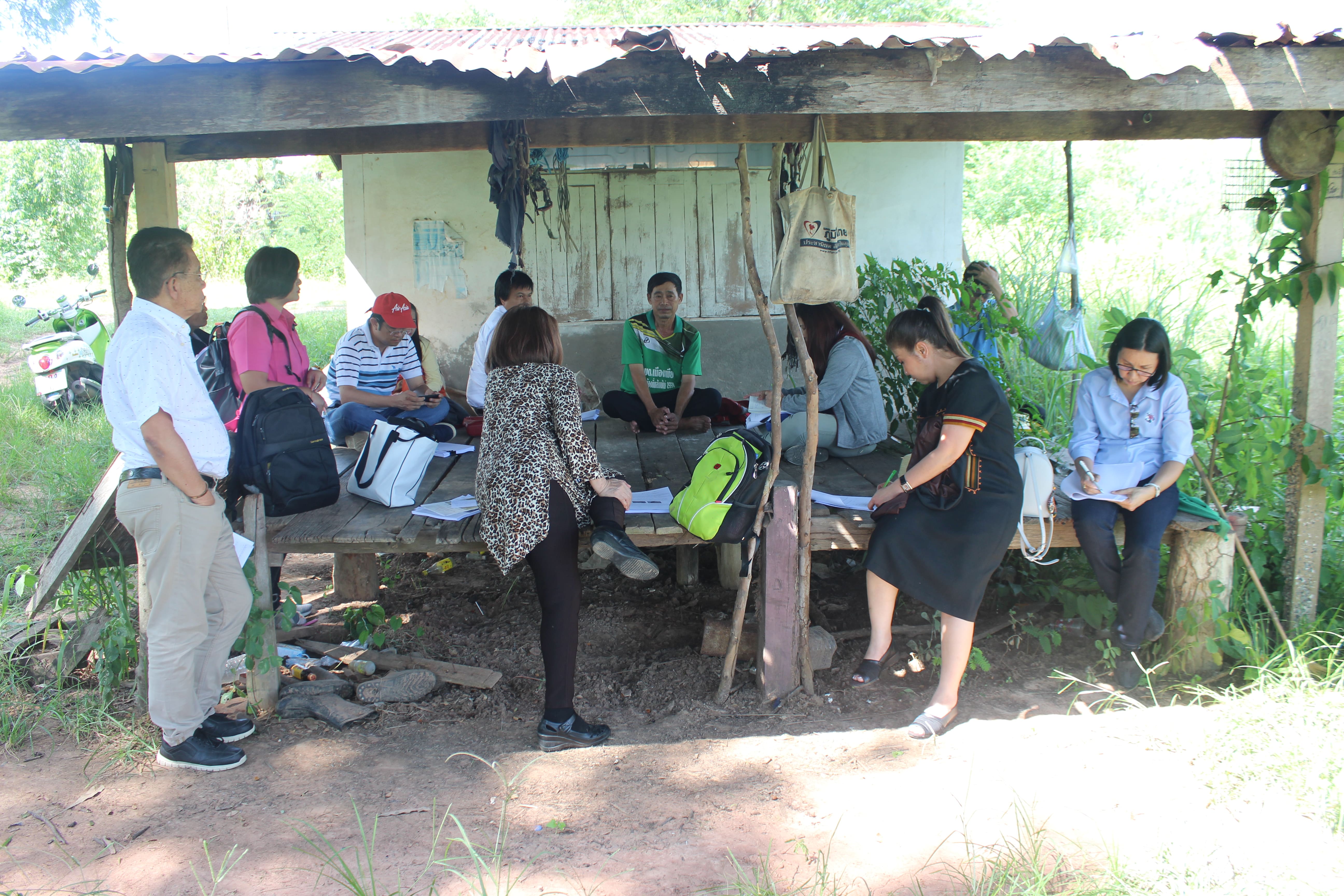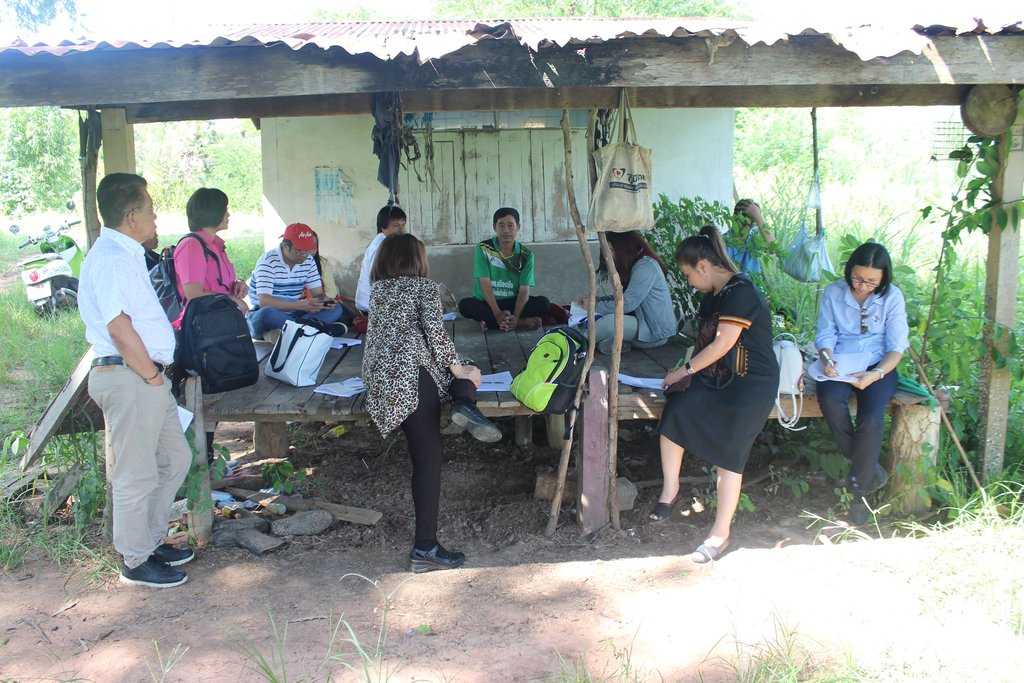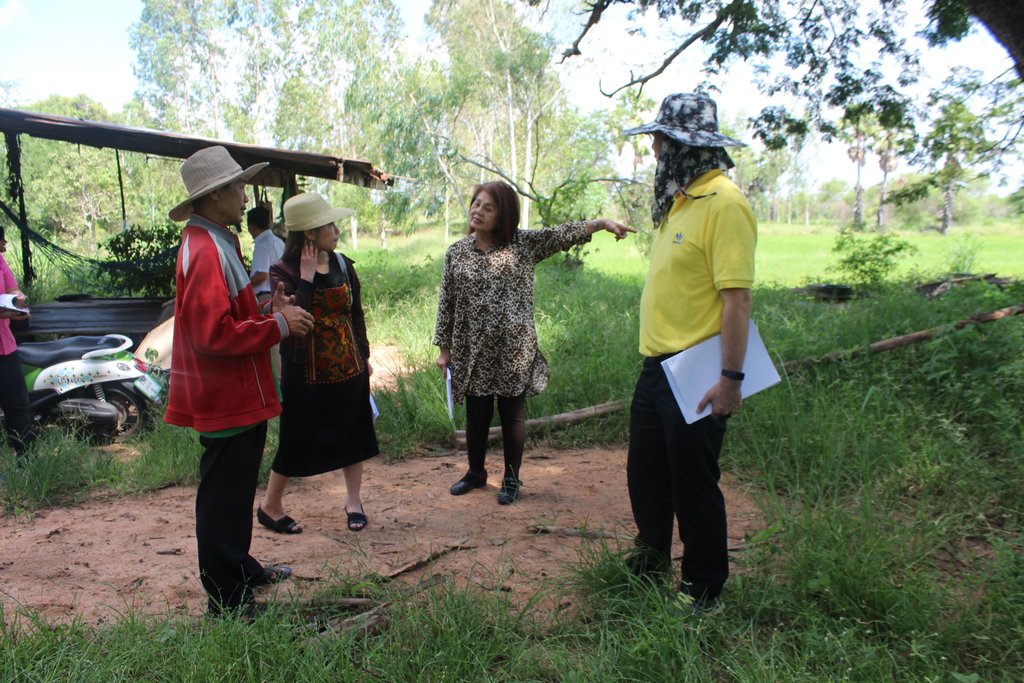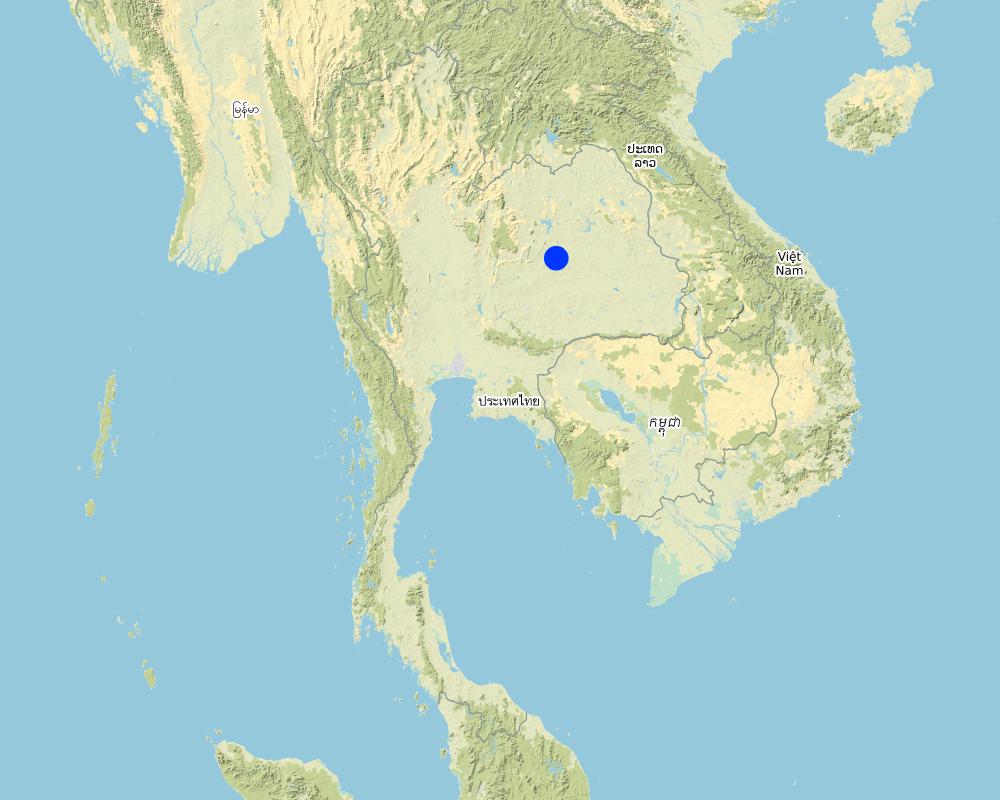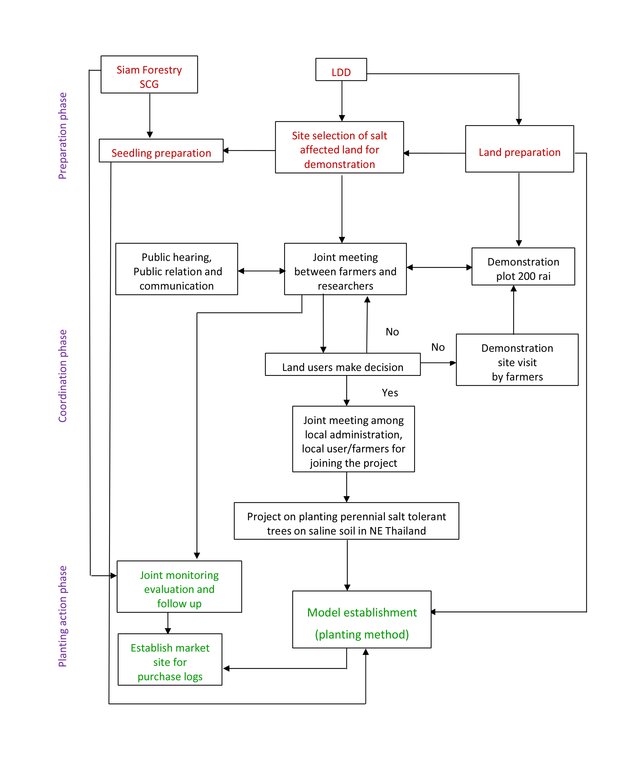Advisory system for planting Eucalyptus camaldulensis on rice bunds in salt-affected areas. [Thaïlande]
- Création :
- Mise à jour :
- Compilateur : Areerat Wangkaew
- Rédacteur : –
- Examinateurs : Rima Mekdaschi Studer, Samran Sombatpanit, Pitayakon Limtong, William Critchley
approaches_4103 - Thaïlande
Voir les sections
Développer tout Réduire tout1. Informations générales
1.2 Coordonnées des personnes-ressources et des institutions impliquées dans l'évaluation et la documentation de l'Approche
Personne(s) ressource(s) clé(s)
exploitant des terres:
Chearnchai Sayan
Ban Muang Pia, Muang Pia Sub-disdrict, Ban Phai District, Khon Kaen Province
Thaïlande
exploitant des terres:
Pannut Pensri
Ban Muang Pia, Muang Pia Sub-disdrict, Ban Phai District, Khon Kaen Province
Thaïlande
exploitant des terres:
Kraisuea Perm
Ban Muang Pia, Muang Pia Sub-disdrict, Ban Phai District, Khon Kaen Province
Thaïlande
exploitant des terres:
Mulae Sommart
Ban Muang Pia, Muang Pia Sub-disdrict, Ban Phai District, Khon Kaen Province
Thaïlande
exploitant des terres:
Leelarat Wasana
+66-94-2988728
Ban Muang Pia, Muang Pia Sub-disdrict, Ban Phai District, Khon Kaen Province
Thaïlande
exploitant des terres:
Chuenjai Sompong
Ban Muang Pia, Muang Pia Sub-disdrict, Ban Phai District, Khon Kaen Province
Thaïlande
Spécialiste GDT:
Srihaban Pranee
pranee.782@gmail.com
Land Development Department
2003, 61 Phaholyothin Road, Ladyao, Chatuchak, Bangkok 10900
Thaïlande
Spécialiste GDT:
Sritumboon Supranee
ssritumboon@yahoo.com
Land Development Department
2003, 61 Phaholyothin Road, Ladyao, Chatuchak, Bangkok 10900
Thaïlande
Spécialiste GDT:
Pothinam Pornpana
laosuwan18@hotmail.com
Land Development Department
2003, 61 Phaholyothin Road, Ladyao, Chatuchak, Bangkok 10900
Thaïlande
Spécialiste GDT:
Rophandung Weera
weerop@hotmail.com
Land Development Department
2003, 61 Phaholyothin Road, Ladyao, Chatuchak, Bangkok 10900
Thaïlande
Spécialiste GDT:
Jakkarach Usa
usa_kl@hotmail.com
Land Development Department
2003, 61 Phaholyothin Road, Ladyao, Chatuchak, Bangkok 10900
Thaïlande
Spécialiste GDT:
Janplang Chettaruj
joeshua9@hotmail.com
Land Development Department
2003, 61 Phaholyothin Road, Ladyao, Chatuchak, Bangkok 10900
Thaïlande
Spécialiste GDT:
Thamphinon Krainukun
+66-89-9449829
krainukt@scg.com
Phoenix Pulp and Paper Plc Ltd.
Kutnamsai Sub-district, Nam Phong District, Khon Kaen Province
Thaïlande
Spécialiste GDT:
Tharachom Thawatchai
+66-81-9172140
thawatct@scg.com
Phoenix Pulp and Paper Plc Ltd.
Kutnamsai Sub-district, Nam Phong District, Khon Kaen Province
Thaïlande
National consultant:
Arunin Somsri
ssarunin@gmail.com
Land Development Department
2003, 61 Phaholyothin Road, Ladyao, Chatuchak, Bangkok 10900
Thaïlande
Nom du projet qui a facilité la documentation/ l'évaluation de l'Approche (si pertinent)
Decision Support for Mainstreaming and Scaling out Sustainable Land Management (GEF-FAO / DS-SLM)Nom du ou des institutions qui ont facilité la documentation/ l'évaluation de l'Approche (si pertinent)
Land Development Department LDD (Land Development Department LDD) - Thaïlande1.3 Conditions relatives à l'utilisation par WOCAT des données documentées
Quand les données ont-elles été compilées (sur le terrain)?
26/09/2018
Le compilateur et la(les) personne(s) ressource(s) acceptent les conditions relatives à l'utilisation par WOCAT des données documentées:
Oui
1.4 Références au(x) questionnaire(s) sur les Technologies de GDT
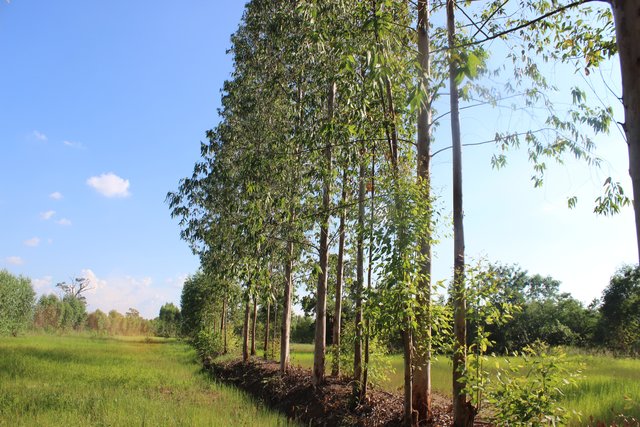
Planting Eucalyptus on rice bunds to lower saline … [Thaïlande]
Eucalyptus camaldulensis variety H4 is salt tolerant and has the ability to lower shallow saline groundwater levels; as a result salinity is controlled. Planting eucalyptus on one or two sides of the rice bund in an east-west direction (in single or double rows) at a spacing of 2 m between …
- Compilateur : Areerat Wangkaew
2. Description de l'Approche de GDT
2.1 Courte description de l'Approche
The Thai government promotes planting of Eucalyptus camaldulensis on rice bunds to lower the saline groundwater level and prevent the spread of salt in soils - through cooperation of farmers, land owners, Siam Forestry Co., Ltd., Subdistrict Administration Organization, Land Development Department, and with specialists/ technical advisors.
2.2 Description détaillée de l'Approche
Description détaillée de l'Approche:
The Ministry of Agriculture and Cooperatives through the Land Development Department (LDD) has initiated a project on planting salt-tolerant perennial trees on salt-affected land in the Northeast of Thailand. Thus, this project, which began in 1996 facilitated planting Eucalyptus camaldulensis on rice bunds. The main objective of the approach is to encourage and support the land users to plant Eucalyptus camaldulensis on rice bunds in salt-affected land with shallow saline groundwater. The target of planting is 1,000 rai/yr (1 ha = 6.25 rai).
The activities started with public meetings under the local administration, identifying salt-affected areas by SLM specialists and preparing soil salinity maps; establishing demonstration plots by SLM specialists and farmers, on farmers' land, as learning centers and communicating. The local administration called farmers’ meetings to prepare detailed work plans and discussion of strengths, weaknesses, opportunities, and threats of planting eucalyptus. The methods used were questionnaires and interviewing the stakeholders for their willingness to take part and cooperate with LDD SLM specialists, researchers, and experts. The LDD has provided funding for land preparation and planting cost while corporates such as Siam Forestry Co., Ltd. purchase eucalyptus poles through a contract. The Bank for Agriculture and Agricultural Cooperatives provides loans to land users.
There are three phases: the preparation phase which was seedling preparation, site selection for establishment of a demonstration plot, rice bund preparation, and establishing a demonstration plot of 200 rai at Ban Kham Riang, Muang Pia Sub-district, Banphai District, Khon Kaen Province. The coordination phase included joint meetings between farmers and researchers, joint monitoring, evaluation and follow-up with land users, and site visits to the demonstration plot. Then planting and tree establishment on farmers’ land in the salt-affected area – those farmers who were convinced by the results of the demonstration plots, Those farmers were then supported by the project on Planting Salt-Tolerant Perennial Trees on Saline Soils in the Northeast of Thailand. A market was established for the purchase of logs. There was joint monitoring & evaluation and follow up.
Results from interviews show that land users favor this project and the spread of eucalyptus planting by themselves - due to the perceived decrease in salination as well as higher income from better rice production, plus additional income from selling poles. However, there are some negative effects of fallen eucalyptus leaves (some farmers believe eucalyptus produces organic compounds detrimental to rice yield through “allelopathy”) and there was shading of the rice crop. But in some site visits there were no effects found. Furthermore, the favorable microclimate is cooler, local earth worms which used to be absent now returning, resulting in better soil properties. However, more birds and rats dwelling in this better environment became a disadvantage because they damaged the rice yield. Nevertheless, as there are more advantages than disadvantages, farmers still adopt this technology. It has been found that more than 10,000 rai (1,600 ha) with shallow saline groundwater of the salt-affected land were planted with eucalyptus trees on rice bunds in the low-lying salt-affected discharge area.
2.3 Photos de l'approche
2.4 Vidéos de l'Approche
Commentaire, brève description:
SLM discussion and explanation
Date:
26/09/2018
Lieu:
Ban Muang Pia
Nom du vidéaste:
Supranee Sritumboon
2.5 Pays/ région/ lieux où l'Approche a été appliquée
Pays:
Thaïlande
Région/ Etat/ Province:
Khon Kaen
Autres spécifications du lieu :
Ban Phai
Map
×2.6 Dates de début et de fin de l'Approche
Indiquez l'année de démarrage:
2009
Commentaires:
This approach has been used since 1996 until now (the LDD project started in 1996 but the land user interviewed started planting Eucalyptus in 2009).
2.7 Type d'Approche
- fondé sur un projet/ programme
2.8 Principaux objectifs de l'Approche
The main objective of the approach is to reduce salinity by encouraging and supporting land users to plant Eucalyptus camaldulensis, with a planting target of 1,000 rai/year (1 ha = 6.25 rai).
2.9 Conditions favorisant ou entravant la mise en œuvre de la(des) Technologie(s) appliquée(s) sous l'Approche
normes et valeurs sociales/ culturelles/ religieuses
- favorise
The land users follow what their neighbours practice.
disponibilité/ accès aux ressources et services financiers
- favorise
Farmers outside the project may get loan from the Bank for Agriculture and Cooperatives.
cadre institutionnel
- favorise
Local administration
collaboration/ coordination des acteurs
- favorise
Coordinators of the project are soil doctor volunteers and community leaders in the area.
cadre juridique (régime foncier, droits d'utilisation des terres et de l'eau)
- favorise
cadre politique
- favorise
The government has a policy of preventing soil degradation.
gouvernance foncière (prise de décisions, mise en œuvre et application des décisions)
- favorise
connaissances sur la GDT, accès aux supports techniques
- favorise
To provide knowledge for land users in the area.
marchés (pour acheter les intrants, vendre les produits) et prix
- favorise
Through corporate contract
charge de travail, disponibilité de la main-d'œuvre
- favorise
For land users under the project
3. Participation et rôles des parties prenantes impliquées dans l'Approche
3.1 Parties prenantes impliquées dans l'Approche et rôles
- exploitants locaux des terres / communautés locales
Farmers under the project
Planting eucalyptus
- organisations communautaires
Local government (Sub-district Administration Organization)
Call for meeting
- Spécialistes de la GDT/ conseillers agricoles
Land Development Department
Site selection
- chercheurs
Land Development Department
Provide technical recommendation
- secteur privé
Siam Forestry Co., Ltd.
Purchase logs
- gouvernement national (planificateurs, décideurs)
Land Development Department
Funding, planner, decision-makers
Si plusieurs parties prenantes sont impliquées, indiquez l'organisme chef de file ou l'institution responsable:
Land Development Department
3.2 Participation des exploitants locaux des terres/ communautés locales aux différentes phases de l'Approche
| Participation des exploitants locaux des terres/ communautés locales | Spécifiez qui était impliqué et décrivez les activités | |
|---|---|---|
| initiation/ motivation | interactive | Land users in the project based |
| planification | passive | Discussion with land users on the work plan before starting the activity. |
| mise en œuvre | interactive | Land users/farmers in the project |
| suivi/ évaluation | passive | Land users in the project |
3.3 Diagramme/ organigramme (si disponible)
Description:
Process of participating technology development of 3 phases including preparation, coordination and planting action.
Auteur:
Stakeholders concerned
3.4 Prises de décision pour la sélection de la Technologie/ des Technologies
Indiquez qui a décidé de la sélection de la Technologie/ des Technologies à mettre en œuvre:
- principalement les spécialistes de la GDT, après consultation des exploitants des terres
Expliquez:
SLM specialists locate salt-affected areas where shallow saline groundwater area is found. They then consult with land users to agree with the set technology and the shared benefit between LDD in combating salinity problem as well as their additional income with better soil and favorable microclimate.
Spécifiez sur quelle base ont été prises les décisions:
- l'évaluation de connaissances bien documentées en matière de GDT (prises de décision fondées sur des preuves tangibles)?
4. Soutien technique, renforcement des capacités et gestion des connaissances
4.1 Renforcement des capacités/ formation
Une formation a-t-elle été dispensée aux exploitants des terres/ autres parties prenantes?
Oui
Spécifiez qui a été formé:
- exploitants des terres
Formats de la formation:
- zones de démonstration
- réunions publiques
Thèmes abordés:
Reclamation and prevention for salt-affected land with available technology and increased income for farmers.
4.2 Service de conseils
Les exploitants des terres ont-ils accès à un service de conseils?
Oui
Spécifiez si le service de conseils est fourni:
- dans les champs des exploitants?
Décrivez/ commentez:
1. Community soil doctor volunteers from Land Development Department provide knowledge by training farmers in the area.
2. SLM specialists from Land Development Department and specialists of Siam Forestry Co., Ltd. visited and advised farmers in the area.
4.3 Renforcement des institutions (développement organisationnel)
Des institutions ont elles été mises en place ou renforcées par le biais de l'Approche?
- non
4.4 Suivi et évaluation
Le suivi et l'évaluation font ils partie de l'Approche? :
Oui
Commentaires:
SLM specialists from Land Development Department collaborated with Siam Forestry Co., Ltd. and community soil doctor volunteers on the soil conditions, the survival rate and follow up the growth of plants in the area.
Si oui, ce document est-il destiné à être utilisé pour le suivi et l'évaluation?
Oui
Commentaires:
There are various points in this document that are interesting and should be adapted for each area to use for evaluation.
4.5 Recherche
La recherche a-t-elle fait partie intégrante de l’Approche?
Oui
Spécifiez les thèmes:
- technologie
Donnez plus de détails et indiquez qui a mené ces recherches:
The Soil Salinity Research Group, LDD, conducted research on saline groundwater flow path along the landscape in Northeast Thailand with Prof.Dr. Adrian Peck from University of Western Australia, supported by Australian Centre for International Agricultural Research (ACIAR) and another project with Dr. Nico Marcar from Commonwealth Scientific and Industrial Research Organisation (CSIRO) on screening for salt-tolerant trees.
5. Financement et soutien matériel externe
5.1 Budget annuel de la composante GDT de l'Approche
Si le budget annuel précis n'est pas connu, indiquez une fourchette:
- 2 000-10 000
Commentez (par ex. principales sources de financement/ principaux bailleurs de fonds):
Land Development Department, Ministry of Agriculture and Cooperatives (MOAC), Thailand
5.2 Soutiens financiers/ matériels fournis aux exploitants des terres
Les exploitants des terres ont-ils reçu un soutien financier/ matériel pour la mise en œuvre de la Technologie/ des Technologies?
Oui
Si oui, spécifiez le(s) type(s) de soutien, les conditions et les fournisseurs:
Assistance in kind, labour cost and seedling supply.
5.3 Subventions pour des intrants spécifiques (incluant la main d'œuvre)
- main d'œuvre
| Dans quelle mesure | Spécifiez les subventions |
|---|---|
| entièrement financé | Rice bund widening as establishment labour cost subsidized by LDD while planting and maintenance costs born by land users. |
- intrants agricoles
| Spécifiez les intrants subventionnés | Dans quelle mesure | Spécifiez les subventions |
|---|---|---|
| seedling | entièrement financé | Free seedlings |
Si la main d'œuvre fournie par les exploitants des terres était un intrant substantiel, elle était:
- volontaire
Commentaires:
Voluntary labour from land users for planting and maintenance has been calculated as labour cost even though LDD did not pay for the labour.
5.4 Crédits
Des crédits ont-ils été alloués à travers l'Approche pour les activités de GDT?
Non
5.5 Autres incitations ou instruments
D'autres incitations ou instruments ont-ils été utilisés pour promouvoir la mise en œuvre des Technologies de GDT?
Oui
Si oui, spécifiez:
1. The policy of Siam Forestry Co., Ltd. to expand the planting area as a source of raw materials for industry and the company organizes a market in the area.
2. This technology encourages farmers to easily access their capital sources such as Bank for Agriculture and Agricultural Cooperatives, while the LDD will send the work plan and names of participating land users to the bank.
6. Analyses d'impact et conclusions
6.1 Impacts de l'Approche
Est-ce que l'Approche a autonomisé les exploitants locaux des terres, amélioré la participation des parties prenantes?
- Non
- Oui, un peu
- Oui, modérément
- Oui, beaucoup
Strengthening relationship between local government administration and land users.
Est-ce que l'Approche a permis la prise de décisions fondées sur des données probantes?
- Non
- Oui, un peu
- Oui, modérément
- Oui, beaucoup
Establish learning center for information to farmers for technology adoption.
Est-ce que l'Approche a aidé les exploitants des terres à mettre en œuvre et entretenir les Technologies de GDT?
- Non
- Oui, un peu
- Oui, modérément
- Oui, beaucoup
Farmers well adopted the technology, resulting in expansion of the areas for such technology.
Est-ce que l'Approche a mobilisé/ amélioré l'accès aux ressources financières pour la mise en œuvre de la GDT?
- Non
- Oui, un peu
- Oui, modérément
- Oui, beaucoup
Land users access to the bank loan supported by LDD project work plan as well as the names of the land users presented to the bank.
Est-ce que l'Approche a amélioré les connaissances et les capacités des exploitants des terres pour mettre en œuvre la GDT?
- Non
- Oui, un peu
- Oui, modérément
- Oui, beaucoup
Farmers have adapted and changed SLM model to suit their own preference.
Est-ce que l'Approche a amélioré les connaissances et les capacités des autres parties prenantes?
- Non
- Oui, un peu
- Oui, modérément
- Oui, beaucoup
There are many other technologies that reduce salinity carried out by LDD.
Est-ce que l'Approche a conduit à améliorer la sécurité alimentaire et/ou la nutrition?
- Non
- Oui, un peu
- Oui, modérément
- Oui, beaucoup
Increased rice yield due to the decrease of soil salinity, resulting in farmers getting higher incomes.
Est-ce que l'Approche a amélioré l'accès aux marchés?
- Non
- Oui, un peu
- Oui, modérément
- Oui, beaucoup
Siam Forestry Co., Ltd. establishes market in the area for the purchase of the product.
6.2 Principale motivation des exploitants des terres pour mettre en œuvre la GDT
- augmenter la production
Increase varieties of products in the area (rice, eucalyptus, livestock).
- réduire la dégradation des terres
Decrease salinity in the soil.
6.3 Durabilité des activités de l'Approche
Les exploitants des terres peuvent-ils poursuivre ce qui a été mis en œuvre par le biais de l'Approche (sans soutien extérieur)?
- oui
Si oui, décrivez de quelle manière:
Farmers have a better understanding and positive attitude of planting eucalyptus, since they obtain additional income from selling eucalyptus logs.
6.4 Points forts/ avantages de l'Approche
| Points forts/ avantages/ possibilités du point de vue de l'exploitant des terres |
|---|
| Community soil doctor volunteer and community leader are the coordinators in the area. |
| Farmers access to markets and sources of Eucalyptus seedlings easily. |
| LDD officers have continually surveyed and followed up in the area. |
| Distribute seedlings free of charge. |
| Good marketing for the purchase and sale in the area. |
| Points forts/ avantages/ possibilités du point de vue du compilateur ou d'une autre personne ressource clé |
|---|
| A supported technique created to develop technology to suit landscape in the Northeast area. |
| Planting eucalyptus knowledge was provided regularly by the Land Development Department and Siam Forestry Co., Ltd. |
| Siam Forestry Co., Ltd. develop marketing covering the Northeast region. |
| A demonstration plot established in the area. |
6.5 Faiblesses/ inconvénients de l'Approche et moyens de les surmonter
| Faiblesses/ inconvénients/ risques du point de vue de l’exploitant des terres | Comment peuvent-ils être surmontés? |
|---|---|
| The LDD officers do not visit when the land users need help. | The officers need to contact the land users and give advice more often. |
| More birds and rats attack rice seeds in the field. | Set up crow scaring; some farmers catch birds and rats to eat. |
| Faiblesses/ inconvénients/ risques du point de vue du compilateur ou d'une autre personne ressource clé | Comment peuvent-ils être surmontés? |
|---|---|
| Farmers planted closer spacing of 1 m, expecting to get more wood product, regardless of the adverse effect on rice. | Clearly illustrate the adverse effect of closer spacing of plants. |
| Income from logs is considered too low. | Changing crops such as olives, figs, dates, pomegranate, etc. |
7. Références et liens
7.1 Méthodes/ sources d'information
- interviews/entretiens avec les exploitants des terres
7 participating farmers
- interviews/ entretiens avec les spécialistes/ experts de GDT
2 officers from Land Development Department
- Stakeholders, local government, and private company
2 officers from Siam Forestry Co., Ltd. and 1 officer from Sub-district Administration Organization
7.2 Références des publications disponibles
Titre, auteur, année, ISBN:
Land Development Department
Disponible à partir d'où? Coût?
http://www.ldd.go.th/
7.3 Liens vers les informations pertinentes disponibles en ligne
Titre/ description:
Planting Eucalyptus on rice bunds: Better way for the Northeast farmers
URL:
http://www.ldd.go.th/
Titre/ description:
Eucalyptus : New opportunity by Siam Forestry
URL:
http://www.scgpackaging.com/others/forestry/eucalyptus/TH
Liens et modules
Développer tout Réduire toutLiens

Planting Eucalyptus on rice bunds to lower saline … [Thaïlande]
Eucalyptus camaldulensis variety H4 is salt tolerant and has the ability to lower shallow saline groundwater levels; as a result salinity is controlled. Planting eucalyptus on one or two sides of the rice bund in an east-west direction (in single or double rows) at a spacing of 2 m between …
- Compilateur : Areerat Wangkaew
Modules
Aucun module trouvé


